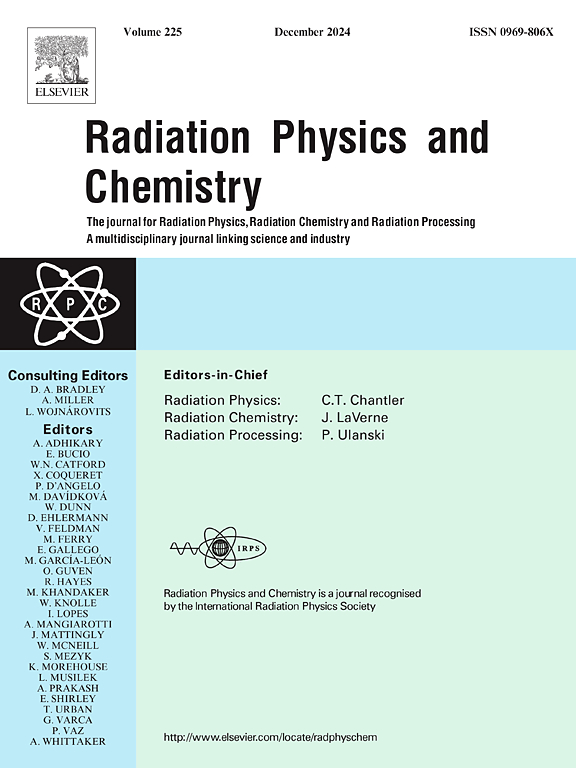Enhanced ionizing radiation shielding using zinc oxide nanorods thin film doped with bismuth nitrate and polyethylene oxide
IF 2.8
3区 物理与天体物理
Q3 CHEMISTRY, PHYSICAL
引用次数: 0
Abstract
The increasing demand for lightweight, eco-friendly, and non-toxic radiation shielding materials has driven significant research into alternatives to conventional shielding solutions. This study focuses on the development of zinc oxide nanorods thin films (ZnONRs-TFs) as a potential candidate for X-ray radiation protection. The films, synthesized via the chemical bath deposition (CBD) technique, were designed in single-layer and double-layer configurations combined with bismuth nitrate (BN) and PEO polymer. Their shielding properties were evaluated through both experimental measurements and Monte Carlo simulations across an X-ray photon energy range of 60–120 kVp. The results revealed that at lower energy levels (60–80 kVp), ZnONRs-TFs doped with 1g of BN exhibited superior shielding performance, attributed to the high atomic number (Z = 83), which enhances photon absorption. In addition, thinner films demonstrated higher linear attenuation coefficients (μ) due to improved packing density, filling interstitial spaces and voids within the nanostructure. At higher energy levels (90–120 kVp), a notable reduction in shielding performance was observed for all samples, driven by increased photon penetration and the prevalence of Compton scattering. Monte Carlo simulations showed strong agreement with experimental results at higher kVp levels (less than 2 % deviation), while discrepancies (∼20 %) at lower energies were attributed to experimental uncertainties, including X-ray tube calibration and secondary photon contributions. The ZnONRs-TFs doped with 1g of BN configuration enhanced shielding across all energy ranges, highlighting its potential as a sustainable and lightweight alternative for ionizing radiation protection. This study contributes to advancing thinner, environmentally friendly radiation shielding materials through nanotechnology.掺杂硝酸铋和聚乙烯氧化物的氧化锌纳米棒薄膜增强电离辐射屏蔽
对轻质、环保和无毒辐射屏蔽材料的需求日益增长,推动了对传统屏蔽解决方案替代品的重大研究。本研究的重点是开发氧化锌纳米棒薄膜(ZnONRs-TFs)作为x射线辐射防护的潜在候选材料。采用化学浴沉积(CBD)技术合成了硝酸铋(BN)和聚氧乙烯(PEO)聚合物的单层和双层膜。通过实验测量和蒙特卡罗模拟,在60-120 kVp的x射线光子能量范围内评估了它们的屏蔽性能。结果表明,在较低能级(60-80 kVp)下,掺杂1g BN的znonrs - tf表现出优异的屏蔽性能,这是由于其高原子序数(Z = 83),增强了光子吸收。此外,薄膜的线性衰减系数(μ)更高,这是由于填充密度的提高、纳米结构内部的间隙和空隙的填充。在更高的能级(90-120 kVp)下,由于光子穿透性增加和康普顿散射的盛行,所有样品的屏蔽性能都显著降低。蒙特卡罗模拟显示,在较高的kVp水平下(偏差小于2%)与实验结果非常吻合,而在较低能量下的差异(~ 20%)归因于实验不确定性,包括x射线管校准和二次光子贡献。掺杂1g BN结构的znonrs - tf增强了在所有能量范围内的屏蔽,突出了其作为可持续和轻量级的电离辐射防护替代品的潜力。这项研究有助于通过纳米技术推进更薄、更环保的辐射屏蔽材料。
本文章由计算机程序翻译,如有差异,请以英文原文为准。
求助全文
约1分钟内获得全文
求助全文
来源期刊

Radiation Physics and Chemistry
化学-核科学技术
CiteScore
5.60
自引率
17.20%
发文量
574
审稿时长
12 weeks
期刊介绍:
Radiation Physics and Chemistry is a multidisciplinary journal that provides a medium for publication of substantial and original papers, reviews, and short communications which focus on research and developments involving ionizing radiation in radiation physics, radiation chemistry and radiation processing.
The journal aims to publish papers with significance to an international audience, containing substantial novelty and scientific impact. The Editors reserve the rights to reject, with or without external review, papers that do not meet these criteria. This could include papers that are very similar to previous publications, only with changed target substrates, employed materials, analyzed sites and experimental methods, report results without presenting new insights and/or hypothesis testing, or do not focus on the radiation effects.
 求助内容:
求助内容: 应助结果提醒方式:
应助结果提醒方式:


